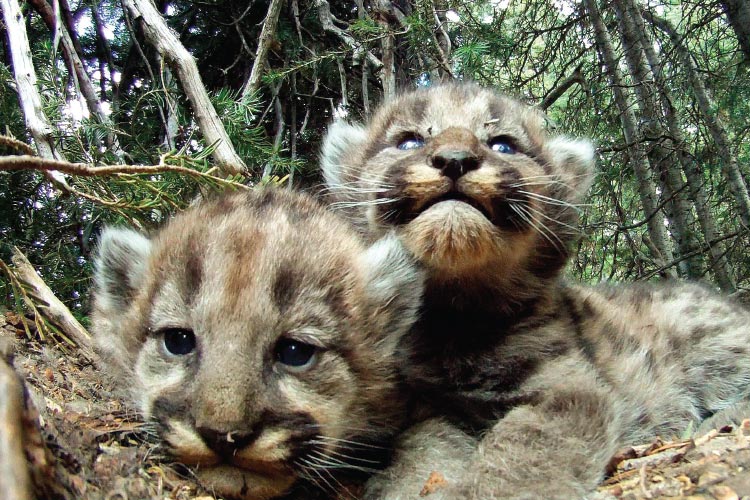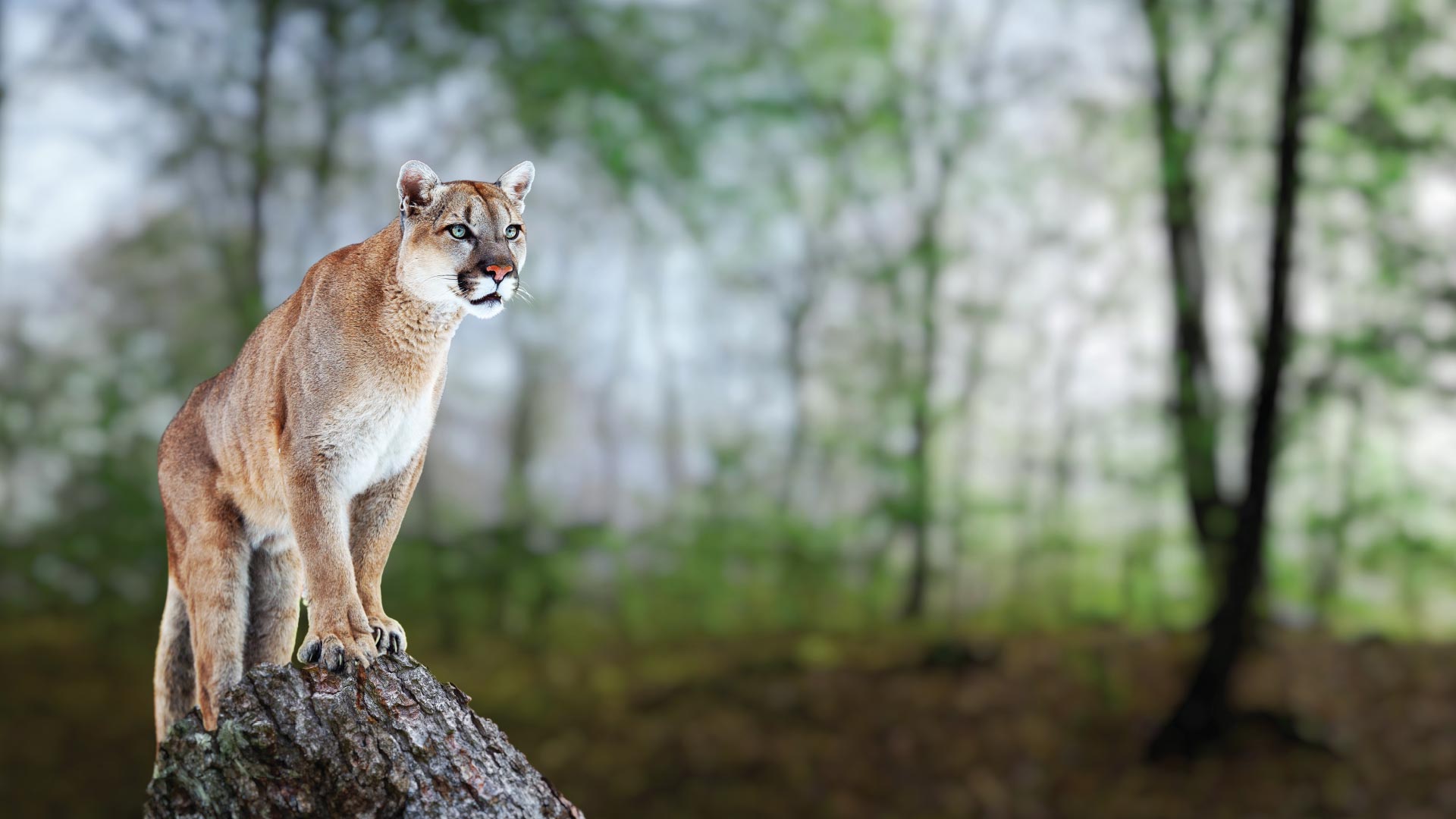Two mountain lion sightings have been confirmed in Tennessee. Another mountain lion was killed on a Connecticut highway. Are these elusive cats prowling the East once again?
The photo is black and white.
It’s 8:02 p.m., according to the timestamp at the bottom of the image. The flash of the game camera extends to a narrow strip of open dirt, worn with muddy boot prints, the deep tread of machinery—and cat tracks.
Standing in the open, left of center, is a slender, fit mountain lion. It’s dark and the image is grainy, but it’s obvious the hind legs pushing the animal forward are tense with muscle. A tail drops straight away from behind them, curling gently before touching the ground, culminating with a black tip carried delicately over the dirt. The animal’s head and front legs are obscured by the tree in the foreground. The scene, even documented as a still photograph, exudes the silence of a ghost in the night.
And until October 2015, to residents of Obion County, Tennessee, the cat was a ghost. Stories of cougars in the area were only that—prevalent enough, but never confirmed. This photo was different. Submitted by a 19-year-old student and hunter to the Tennessee Wildlife Resources Agency from a game camera in one of his favorite hunting spots, this image stood out from the slew the agency receives of purported sightings.
A date and timestamp on the image, as well as the SD card on which it was recorded, convinced the TWRA of when it was taken. Superimposing photos of deer taken with the same camera showed the feline was far larger than a house cat—nearly as long as the deer. Photo analysis proved the cat wasn’t doctored or added later. And finally, the TWRA confirmed the location by returning to the scene and matching the tree, soybeans and path the cat walked along. “The TWRA can confirm there was, on September 20, 2015, a cougar in Obion County, Tennessee,” a statement read.
The problem? With the exception of Southern Florida’s small, endangered panther population, cougars have been extinct east of the Mississippi River since the 1930s.
Cats long gone
Breeding populations of the Eastern cougar—a subcategory of big cats known interchangeably as cougars, mountain lions, pumas or panthers under the species Puma concolor— haven’t been seen since 1938 in Maine. Nonetheless, the subspecies, which originally stretched from Michigan and Tennessee in the west to Eastern Canada, Maine, and South Carolina in the East, was only declared extinct and removed from the Endangered Species List by the U.S. Fish and Wildlife Service earlier this year.
Seen as a threat to livestock and desired for their pelts, Eastern cougars were rounded up and hunted, some with bounties, beginning in the 1800s. At the same time, the cats’ primary food source—deer—were also hunted to near extinction, a historical footnote that seems almost impossible considering today’s overpopulation of the mammal. But between a human assault and a dwindling food source, the Eastern cougar became an early casualty of American expansion.
“There is no Eastern cougar, and there never was an Eastern cougar.”
Likely gone roughly 35 years before the Endangered Species Act was signed into law, it took another 45 years for the cats to be officially labeled extinct and removed from protection. A 2011 review of the subspecies status led to a 2015 proposal to delist the animal. A detailed study to examine reports of sightings dating back as far as 1900 concluded the animals were long gone and the U.S. Fish and Wildlife Service officially took the subspecies off life support.
The species that never was
But according to specialists, the move might be more of a logistical clean-up than a sad goodbye to a once-in-a-genome superpredator. The Eastern Cougar, as it was originally defined, might in fact be extinct, but many experts will argue that it shouldn’t have existed in the first place.
When the Eastern cougar was classified in the early 20th century, taxonomists relied on acute morphological differences between animals to determine if they were the same or a different species. Measurements of skulls and feet, as well as coat color were the main factors that at one time had distinguished 13 subspecies of cougar in North America. But today, according to Dr. Mark Elbroch, the Puma Program lead scientist at the wild cat conservation organization Panthera, there is just one.
“There is no Eastern cougar, and there never was an Eastern cougar,” said Elbroch. Today’s scientists classify species slightly more conservatively and largely through genetic studies, and according to Elbroch, there’s not enough genetic difference between any of the continent’s cougars to justify calling them different subspecies. The East’s big cat, by today’s standards, would have only been considered a regional population of the broader North American mountain lion, Puma concolor—an animal with one of the largest ranges of any mammal in the Western Hemisphere.
Elbroch agreed that the delisting should have happened, but not about why. “There were many scientists who, when the review came forward, took the stance that we need to declassify or remove this endangered species status, not because of local extinction but because of taxonomic error.”
In the end, while Fish and Wildlife noted that the cat likely shouldn’t have been classified separately in the first place, they didn’t fully align with scientists like Elbroch, maintaining that the cougars, as their own distinct subspecies, were extinct.
Regardless of the reasoning, the Eastern Cougar’s extinction and removal as an endangered species opens up new avenues for conservation. According to Michael Robinson of the Center for Biological Diversity, Federal regulations highly control endangered species and any conservation efforts surrounding them. Removing federal protections for the East’s cats makes one thing much easier: reintroduction. According to Robinson, any attempts to previously bring the Western mountain lion to the East would have faced strict regulation for its potential impact to the Eastern Cougar—until this year, legally a separate, and still living subspecies. But with the Eastern Cougar no longer, there’s nothing left to protect.
“Legally, that impediment is gone and it allows us to go forward with the question of ‘What was the role of the Eastern Puma in the ecology of the Midwest and Northeast and how has its disappearance affected that ecology?’” Robinson said.
The doors to bringing back the mountain lion are officially wide open.

Moving back
The 2015 Obion County sighting was hardly the only mountain lion sighting in the East, nor was it even the only confirmed sighting. For years, the cats have been spotted all across their old habitat, including through Appalachia and the Northeast. In 2011, a male mountain lion was hit by a car and killed on a highway in suburban Connecticut. Genetic testing suggested the cougar left South Dakota roughly 2 years and 1,500 miles earlier and traveled through the sprawling Midwest and Northeast without being detected until it was nearly at the Atlantic Ocean.
Young males have been known to bounce around, said Elbroch, and aren’t necessary telling of the species’ range. Nonetheless, the mountain lion’s territory is definitely expanding. Studies that have examined the rate of female mountain lion movement—a far more telling statistic—have concluded that the predators are heading east at a rate of roughly 25 miles every year, though Elbroch says humans have a way of slowing that down. As the cats migrate first into populated areas—generally broad river valleys, which humans also like to populate—scared residents are likely slow or stop their spread entirely. “We have previously exterminated cougars in the East and we can do it again,” he said.
Can cougars help control deer?
With the difficulties associated with cougars naturally making their way east, the more likely—and certainly quicker—option for returning the cougar to its native habitat in the East is a human-led reintroduction. According to Robinson, bringing cougars east would allow them to skip through undesirable and more dangerous environments. It would also likely include a pronounced education program to teach Easterners how to interact with the new predators, as well as a more robust protection program which, currently, is not in place (most states do have some level of protections in place for cougars, but reintroduction would require much more strict hunting laws to be effective).
There were three times more Americans attacked by sharks in 2017 alone than people attacked by cougars on the continent since 1970.
Now that reintroduction—physically bringing cougars from the West to East Coast locations with the hope that they repopulate—has no chance of impacting an endangered and heavily protected Eastern Cougar population, the process would be up to individual states to implement, or work together to do.
“I think it should be discussed,” said Robinson, who pointed to areas like New York’s Adirondack region and National Parks in Appalachia as prime reintroduction locations because of their high deer numbers, ready-to-go protections, a low road density, and smaller winter snowpack.
Elbroch would also welcome states bringing back the cougar but is reluctant to think it will actually happen. “It would be a difficult battle,” he said, largely because of the opinions and fears many Easterners already have toward predators like the mountain lion.
In May 2018, a mountain lion attacked two mountain bikers 30 miles east of Seattle, Washington, killing one, but it’s only the 15th fatal attack in North America since 1970. Since 1890 in the U.S. and Canada, there have been 100 attacks on humans at all, according to the research organization The Cougar Network.
Robinson argues the miniscule risk of cougar attacks (there were three times more Americans attacked by sharks in 2017 alone than people attacked by cougars on the continent since 1970) is far outweighed by the benefits that would be seen by bringing cougars to the East.
“The risks from cougars are risks that people in huge swaths of the United States already take into account and deal with,” he said. “And luckily for them, they don’t end up with Lyme Disease.”
The cougar’s primary prey—deer—are present in the East at historically high levels, leading to an unnatural prevalence of Lyme and other tick-borne diseases, auto accidents, and even the destruction and damage of native flora and fauna by the unnaturally large deer population, all of which he says could be impacted by reintroducing the deer’s natural predator.
According to a paper published by several wildlife biologists in 2016, the reintroduction of cougars to the East would dramatically decrease deer densities and deer-vehicle collisions by 22 percent, preventing 21,400 human injuries, 155 fatalities, and $2.13 billion in costs within 30 years of an established population.
For Elbroch, the ecological impacts of reintroducing a big cat to the East would be tremendous. The disappearance of wildflowers, shrubbery, tree saplings and native grasses have also been linked to overbrowsing by the large deer population. Understory foliage, in turn, impacts birds and smaller animals, all of which would be impacted by cougars and the subsequent decline in the deer population. Deer have also been named as one of the most prolific spreaders of invasive plant species in the East.
“Introducing top predators to ecosystems changes everything, in some unpredictable ways,” he said. “We have no idea what would change in New England if we threw mountains lions in there.” But increased biodiversity and changes in animal patterns would all lead to a more resilient ecosystem, Elbroch said. “Would I like to see it? You bet.”
One way or another, Obion County, Tennessee—and the rest of the East—has likely not seen the last of the ghost cat.







